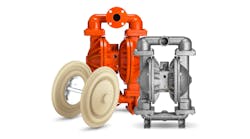Biolubricants use is on the rise as companies look for more sustainable ways of doing business. The process industries can also take advantage of a new generation of biolubricants that is available.
For example, biodegradable fluids are required more often in hydraulic equipment, especially in sensitive environments such as food processing plants, water/wastewater processing and pharmaceutical processing. Biolubricants are also commonly used in agricultural equipment, including cranes, tractors and load carriers, to avoid soil toxicity in an environment where food is produced.
Designed to rapidly biodegrade and be nontoxic to both humans and aquatic life, such lubricants are typically made from vegetable oils rather than mineral oils derived from crude oil. As indicated, biolubricants can include hydraulic oils and oils for engines, axles and gears.
Vested interests
Trelleborg provides engineered polymer solutions and is playing a key role in the adoption of sustainable lubricants through developing compatible sealing solutions for this equipment.
The costs and liabilities associated with spill cleanup and other potential type accidents are making it prudent, if not mandatory, for equipment operators to prefer biodegradable hydraulic fluids. Fluid manufacturers and blenders are meeting these demands as they increase their portfolios with new fluids and promote their formulations on the importance of low toxicity. In turn, hydraulic component and system manufacturers are required to ensure that the products they provide are useful and compatible with fluids and provide for the processor’s requirements.
Special design consideration is required because of how such lubricants may react to equipment components and seal materials.
Hydraulic fluids and seal materials are similar in that both are extremely complex and variable in regard to their formulation. Environmentally friendly hydraulic fluids, like all hydraulic fluids, have considerable variation in their formulations, not only in the selection and blending of the base stocks but also in the variety of additives that can be chosen to give required properties.
Because the chemistry between the lubricant and seal is so complex, the company advises working closely with a component supplier to select the optimal sealing solution when using a biolubricant.
Taking steps
The first step in achieving a suitable lubricant and seal match is to clearly communicate the performance requirements and component-fluid compatibilities to the seal and fluid supplier. Be sure to understand the lubricating system’s operating and design characteristics. These factors include the type of sealing or hose materials used; potential for contamination, such as water or dust and dirt; operating temperature, pressures and flow rates; and whether or not the quality of the existing filtration system is sufficient for the new fluid.
Although they are environmentally friendly and biodegradable, hydraulic fluids are classified for a reason. There are still too many variations inside the classifications to make sweeping generalizations regarding chemical compatibility.
Consideration should also be given to whether the new lubricant is compatible with the existing one. Mixing fluids that are not compatible may cause filtering, de-foaming and water separation issues, to name a few. The general result is a fluid that is less than the sum of its parts. Some additives in one formulation can negate the function of additives in the other formulation.
Prevalent precautions
The company also advises looking at whether the new fluid is compatible with the current sealing system. Determine early in the process the compatibility of currently familiar seal materials to avoid setting up a situation in which you have no choice but to make drastic changes to your seal supply or seal design. Availability and cost are major drivers in seal selection, and having an unplanned change of materials can greatly reduce your options. Seal compatibility goes far beyond a 70-hour soak test, although that is a good place to start if no data is available.
It is important when specifying seal material to be as specific as possible. If experience with the fluid does not result in an acceptable amount of confidence, specifying a compound recipe is recommended.
Many indicators of an inadequate or incomplete conversion to biodegradable fluids exist. These could encompass leaking seals, severe foaming, increased operating temperatures, plugged filters or higher-than-normal wear on some components such as the hydraulic pump. However, by following the steps outlined here, companies aiming to use biolubricants in sensitive environments should achieve a high degree of success.
Specific properties
Some key properties to review when evaluating environmentally friendly hydraulic fluids include:
Viscosity: The viscosity index is a measure of the degree of change in the viscosity of a fluid as changes in temperature occur. Suppliers need to evaluate the viscosity index as it factors in a hydraulic fluid’s performance, especially when wide fluctuations in the fluid’s temperature exist.
Compatibility: The fluid needs to be relatively inert in its reaction to the materials of construction and must be compatible with the system’s seals and finishes. The fluid must be thermal and shear stable to resist breakdown from oxidation and bacteria while also being non-reactive with all system components.
Low/high pressure: Low vapor pressure is important to prevent cavitation and high wear rates of the hydraulic pumps. High vapor pressures of some water-based hydraulic fluids result in significant cavitation problems.
Compressibility: Typically, the compressibility of fluids used for hydraulic purposes is insignificant at pressures up to 3,000 psi. High compressibility results in lower efficiency and higher apparent viscosity characteristics. Low foaming properties are essential to efficient operation. Serious foaming problems can result in cavitation of the pumps and excessive wear.
Lubricity: Good lubricity increases in importance as the operating system pressure increases. Systems that operate at pressures greater than a few hundred psi usually require incorporating anti-wear agents to reduce friction and wear.
Low specific gravity: The higher the specific gravity of the fluid, the lower the overall operating efficiency is.
Non-flammability (high flash point): With hydraulics, non-flammability is often an essential property of the fluid. Some applications require a specially designed fire-resistant fluid. Flammability is usually measured by flash and fire points.
High heat transfer capabilities: This is important to aid in removal of the heat generated in normal pumping and use of the hydraulic fluid.
Demulsibility: As a measure of oil’s ability to resist emulsification with water, for most systems it is desirable that the hydraulic fluid resists emulsification and allows for the separation and removal of water.
Low pour point: A low pour point is vital for fluids used outdoors in cold climates. Pour point is a measure of the lowest temperature at which a fluid can be poured. Recommendations for pour points should be at least 10 to 20°F below the lowest actual operating temperature.
Joe Savina is a fluid power application engineer for Trelleborg Sealing Solutions. He is an expert in seal design, mechanical engineering and manufacturing for fluid power applications, and he has worked for Trelleborg in various engineering positions for more than 17 years. Savina has degrees in industrial maintenance and physics.


